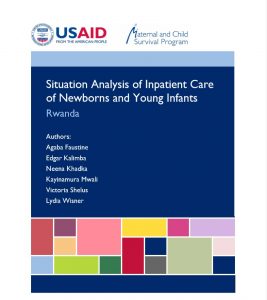
USAID’s flagship Maternal and Child Survival Program (MCSP) is excited to share the final report from the recent Situation Analysis of Inpatient Care of Newborns and Young Infants in Rwanda.
Newborn lives can be saved and morbidity prevented by implementing an integrated health systems approach along the continuum of care that identifies high-risk newborns and provides timely, quality inpatient care. It is a global priority to increase the effective coverage and quality of key routine practices (known as essential newborn care [ENC]) in the care of the newborn, particularly at the time of birth and over the first hours of life, whether in the health facility or at home, and to build and strengthen care for small and sick newborns, which is much less developed. It has been estimated that optimal supportive care in a hospital’s Special Newborn Care Unit (SNCU) could avert 70% of newborn deaths due to preterm birth complications, and 90% could be averted with availability of hospital newborn intensive care units (NICUs). A first step in the process of improving inpatient care of the newborn and young infant (NYI) is to understand the landscape of care through a situation analysis.
Rwanda’s Ministry of Health (MOH), with support from the US Agency for International Development (USAID)’s flagship Maternal and Child Survival Program (MCSP), conducted a situation analysis of inpatient care of NYIs to identify gaps within the continuum of care and to establish the link between the needs of small and sick newborns and the capacity of the health system to respond accordingly. The situation analysis adapted protocol and tools developed jointly by USAID, Every Preemie–Scale, MCSP, UNICEF, the World Health Organization (WHO), University Research Co./Applying Science to Strengthen and Improve Systems Project, Saving Newborn Lives, the London School of Hygiene and Tropical Medicine, and the Global Health Supply Chain Program. The landscape analysis includes components of policy, implementation strategy, service readiness, and systems to support quality services and clinical practices.